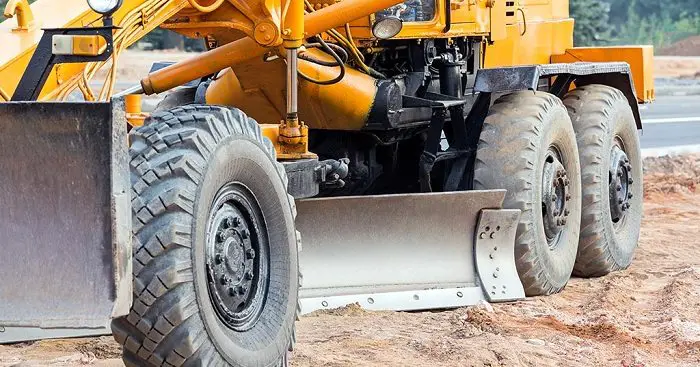A Motor grader is the stalwart of the construction process. Given that this heavy-duty machine does the hard work, it needs to be looked after so that it continues to perform optimally. According to Sanna Halttunen of Veekmas in Finland, a good motor graders is one which is capable and diversified to different operating tasks. It should also be heavy enough and have enough horse power. A heavy motor grader guarantees a long operating life while the enough horse power ensures efficient operation. It also requires the highest level of operator technique.
The entire motor grader machine is developed around its blade, or moldboard, and its precise movement – from the turntable and frame, to the hydraulic cylinders and gears. All these parts need to be well maintained.
Also Read Top construction equipment suppliers in USA
In general, you should follow the manufacturer’s guidelines for checking parts and getting them serviced, and don’t overlook the basics, such as the fan belt, engine oil and battery contacts. According to Rethal Lombard from ELB Equipment, it is important to ensure that the operator of the machine is properly trained to do routine maintenance and to operate the machine correctly. She adds that, it is important to adhere to the manufacturers recommendations and make use of OEM parts from ELB especially regarding oil, parts and consumable products. Hidromek graders are made for Africa and supported by Africa’s best equipment supplier, ELB Equipment
Motor grader maintenance tips
The blade/moldboard
This is the part that engages directly with the soil, so special attention needs to be given to its cutting edge.
Wear and tear on the cutting blade, or blades, attached to the moldboard is high, especially if the blade is pitched back, rather than at right angles. For this reason, blades need to be inspected and replaced regularly – in some instances, even per day. Depending on the surface being prepared, blades should be checked after every 25 to 50 hours of operation.
If the blade gets too worn down before it’s replaced, the moldboard will be compromised. If you fail to maintain the blade’s edges and the bolts that keep them in place, you may end up needing to replace the moldboard.
Blade slide and turntable
The blade slide allows the moldboard to move on a swivel track, and it should be checked every month or so. The bronze or metal shim glides that control the blade slide’s movement can also wear down.
Fortunately, removing and replacing the glides, which are situated on four different points and should all be replaced simultaneously, is a quick and easy process. To ensure your machine gives you the fine cut you want, the brushings in the slide also can’t give too much play. If the slide’s movement is too loose, the clevis pins keeping it in place need to be replaced.
Air filters
If dirt clogs your machine’s air filters, their efficacy will be compromised and the motor grader will consume more fuel.
Check your air filters as per manufacturer recommendations and keep an eye on the “restricted alert” signal, if your machine has one, which alerts you to problems with airflow. Pre-filters do a good job of reducing the amount of dirt that enters the air filter, so they can be fitted to prevent you having to change the air filter as often.
Scarifiers
Standard on some machines and optional on others, these lessen the work of the moldboard for rough grading or cut-outs. The “teeth” of the scarifier shouldn’t wear down to the point of reaching the scarifier shank, or pocket. If that happens, you’ll have to replace the shank − a far costlier task than replacing the teeth.
Operator station and controls
To ensure precision and operator safety, the seatbelt, floor mat and handles need to be checked regularly. Loose blade handles will also make jobs more difficult, especially where precise work is called for.
Tyres
Tyre traction affects the machine’s grade, so tyre pressure needs to be carefully monitored. The tyre tread is also essential to the machine getting “good bite” on the ground. A half-inch deep is the absolute minimum for agrader’s tyre tread.In addition to the points above, general maintenanceincludes keeping an eye on the hydraulic cylinder; checking all seals; greasing andlubricating;and regularly checking for any suspicious leaks or drips.
According to Mr. Fan of Sunyo Machinery Company Ltd, with numerous technological advancements the world is now a global village; therefore, the machinery produced worldwide are on the same platform. “The Chinese machinery have now improved over the years in terms of quality and also pricing. Clients can confidently buy machinery from China without the fear of regular maintenance,” he added.
Mr. Amarnath Ramachandran President and Director of LeeBoy India Construction equipment (P) Ltd argues that, the exact application of the motor grader and utilization in terms of hours per day will help you select the type of equipment, size and requisite attachments for the motor grader. “In most cases, buyers purchase motor graders based on credit terms, availability finance and long term discounts on spare parts and service. However, maintenance and spares support is also very important,” he said.

“Africa is an exciting continent. It has a lot of diversity and tremendous potential for the construction industry in terms of general construction, mining and development of infrastructure,” he added.


